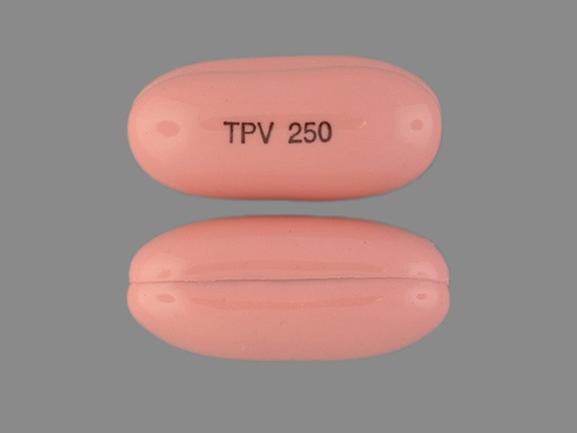Aptivus Disease Interactions
There are 4 disease interactions with Aptivus (tipranavir).
Tipranavir (applies to Aptivus) hepatotoxicity
Major Potential Hazard, High plausibility. Applicable conditions: Liver Disease
The use of tipranavir is contraindicated in patients with moderate to severe (Child-Pugh Class B and C) hepatic impairment. Tipranavir is primarily metabolized by the liver and may accumulate substantially in such patients. In addition, tipranavir coadministered with ritonavir 200 mg has been associated with reports of clinical hepatitis and hepatic decompensation, including some fatalities. Most cases occurred in patients with advanced HIV disease taking multiple concomitant medications, thus a causal relationship to tipranavir/ritonavir could not be established. Nevertheless, extra caution is recommended if tipranavir and ritonavir are prescribed to patients with chronic hepatitis B or C coinfection or elevations in liver transaminases, as these patients have an approximately 2.5- fold increased risk of developing further transaminase elevations or hepatic decompensation. In clinical studies, Grade 3 and 4 increases in hepatic transaminases were observed in 6% of healthy volunteers and HIV subjects. Liver function tests should be performed prior to initiating therapy and frequently throughout the duration of treatment. Patients should be advised to promptly discontinue tipranavir/ritonavir therapy and seek medical attention if they experience signs or symptoms suggestive of hepatotoxicity such as fever, rash, anorexia, nausea, vomiting, fatigue, right upper quadrant pain, dark urine, and jaundice.
PIs (applies to Aptivus) hemophilia
Moderate Potential Hazard, Moderate plausibility. Applicable conditions: Coagulation Defect
There have been reports of increased bleeding, including spontaneous skin hematomas and hemarthrosis, in patients with hemophilia type A and B treated with protease inhibitors; however, a causal relationship has not been established. In some patients, additional factor VIII was given. In more than half of the reported cases, protease inhibitor therapy was continued or reintroduced. Patients with hemophilia or other coagulation defects should be monitored closely for bleeding during protease inhibitor therapy.
PIs (applies to Aptivus) hyperglycemia
Moderate Potential Hazard, Moderate plausibility. Applicable conditions: Abnormal Glucose Tolerance, Diabetes Mellitus
New onset diabetes mellitus, exacerbation of preexisting diabetes mellitus, hyperglycemia, and some cases of diabetic ketoacidosis have been reported during postmarketing surveillance in HIV-infected patients treated with protease inhibitors. Some patients required either initiation or dosage adjustments of insulin or oral hypoglycemic agents for treatment of these events. In some cases, hyperglycemia persisted despite discontinuation of protease inhibitor therapy. A causal relationship has not been established between protease inhibitor therapy and these events. Monitoring patients for hyperglycemia, new onset diabetes mellitus, or exacerbation of diabetes mellitus should be considered during protease inhibitor therapy.
PIs (applies to Aptivus) hyperlipidemia
Moderate Potential Hazard, Moderate plausibility.
Treatment with ritonavir alone or in combination with other protease inhibitors (e.g., lopinavir, saquinavir, tipranavir, fosamprenavir) has resulted in substantial increases in the concentration of total cholesterol and triglycerides. These effects have also been reported with other protease inhibitors but may be the most dramatic with ritonavir. The clinical significance of these elevations is unclear. Marked elevation in triglyceride levels is a risk factor for development of pancreatitis. Triglyceride and cholesterol testing is recommended before starting ritonavir (with or without other protease inhibitors) and periodically during therapy. Lipid disorders should be managed as clinically appropriate.
Switch to professional interaction data
Aptivus drug interactions
There are 405 drug interactions with Aptivus (tipranavir).
Aptivus alcohol/food interactions
There are 2 alcohol/food interactions with Aptivus (tipranavir).
More about Aptivus (tipranavir)
- Aptivus consumer information
- Check interactions
- Compare alternatives
- Pricing & coupons
- Drug images
- Side effects
- Dosage information
- During pregnancy
- FDA approval history
- Drug class: protease inhibitors
- Breastfeeding
- En español
Related treatment guides
Drug Interaction Classification
| Highly clinically significant. Avoid combinations; the risk of the interaction outweighs the benefit. | |
| Moderately clinically significant. Usually avoid combinations; use it only under special circumstances. | |
| Minimally clinically significant. Minimize risk; assess risk and consider an alternative drug, take steps to circumvent the interaction risk and/or institute a monitoring plan. | |
| No interaction information available. |
See also:
Further information
Always consult your healthcare provider to ensure the information displayed on this page applies to your personal circumstances.


